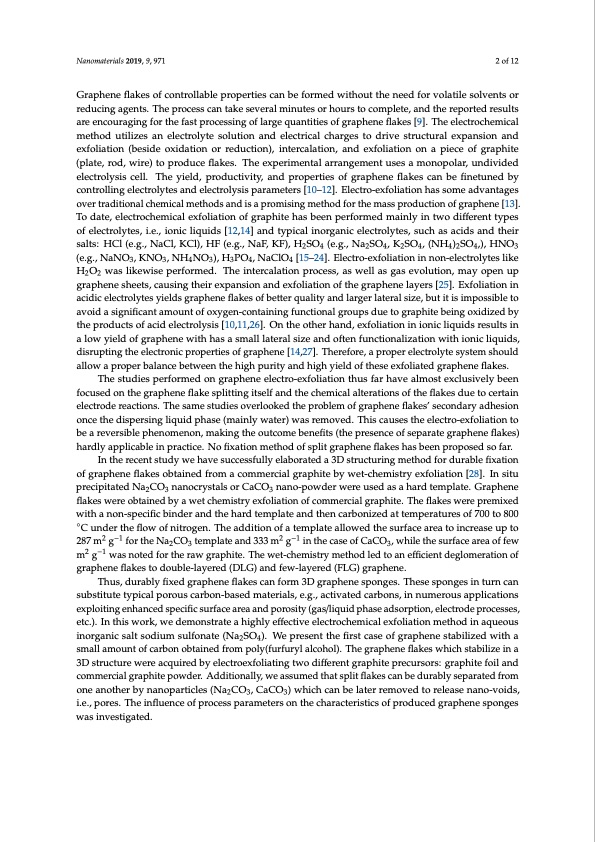
PDF Publication Title:
Text from PDF Page: 002
Nanomaterials 2019, 9, 971 2 of 12 Graphene flakes of controllable properties can be formed without the need for volatile solvents or reducing agents. The process can take several minutes or hours to complete, and the reported results are encouraging for the fast processing of large quantities of graphene flakes [9]. The electrochemical method utilizes an electrolyte solution and electrical charges to drive structural expansion and exfoliation (beside oxidation or reduction), intercalation, and exfoliation on a piece of graphite (plate, rod, wire) to produce flakes. The experimental arrangement uses a monopolar, undivided electrolysis cell. The yield, productivity, and properties of graphene flakes can be finetuned by controlling electrolytes and electrolysis parameters [10–12]. Electro-exfoliation has some advantages over traditional chemical methods and is a promising method for the mass production of graphene [13]. To date, electrochemical exfoliation of graphite has been performed mainly in two different types of electrolytes, i.e., ionic liquids [12,14] and typical inorganic electrolytes, such as acids and their salts: HCl (e.g., NaCl, KCl), HF (e.g., NaF, KF), H2SO4 (e.g., Na2SO4, K2SO4, (NH4)2SO4,), HNO3 (e.g., NaNO3, KNO3, NH4NO3), H3PO4, NaClO4 [15–24]. Electro-exfoliation in non-electrolytes like H2O2 was likewise performed. The intercalation process, as well as gas evolution, may open up graphene sheets, causing their expansion and exfoliation of the graphene layers [25]. Exfoliation in acidic electrolytes yields graphene flakes of better quality and larger lateral size, but it is impossible to avoid a significant amount of oxygen-containing functional groups due to graphite being oxidized by the products of acid electrolysis [10,11,26]. On the other hand, exfoliation in ionic liquids results in a low yield of graphene with has a small lateral size and often functionalization with ionic liquids, disrupting the electronic properties of graphene [14,27]. Therefore, a proper electrolyte system should allow a proper balance between the high purity and high yield of these exfoliated graphene flakes. The studies performed on graphene electro-exfoliation thus far have almost exclusively been focused on the graphene flake splitting itself and the chemical alterations of the flakes due to certain electrode reactions. The same studies overlooked the problem of graphene flakes’ secondary adhesion once the dispersing liquid phase (mainly water) was removed. This causes the electro-exfoliation to be a reversible phenomenon, making the outcome benefits (the presence of separate graphene flakes) hardly applicable in practice. No fixation method of split graphene flakes has been proposed so far. In the recent study we have successfully elaborated a 3D structuring method for durable fixation of graphene flakes obtained from a commercial graphite by wet-chemistry exfoliation [28]. In situ precipitated Na2CO3 nanocrystals or CaCO3 nano-powder were used as a hard template. Graphene flakes were obtained by a wet chemistry exfoliation of commercial graphite. The flakes were premixed with a non-specific binder and the hard template and then carbonized at temperatures of 700 to 800 ◦C under the flow of nitrogen. The addition of a template allowed the surface area to increase up to 287 m2 g−1 for the Na2CO3 template and 333 m2 g−1 in the case of CaCO3, while the surface area of few m2 g−1 was noted for the raw graphite. The wet-chemistry method led to an efficient deglomeration of graphene flakes to double-layered (DLG) and few-layered (FLG) graphene. Thus, durably fixed graphene flakes can form 3D graphene sponges. These sponges in turn can substitute typical porous carbon-based materials, e.g., activated carbons, in numerous applications exploiting enhanced specific surface area and porosity (gas/liquid phase adsorption, electrode processes, etc.). In this work, we demonstrate a highly effective electrochemical exfoliation method in aqueous inorganic salt sodium sulfonate (Na2SO4). We present the first case of graphene stabilized with a small amount of carbon obtained from poly(furfuryl alcohol). The graphene flakes which stabilize in a 3D structure were acquired by electroexfoliating two different graphite precursors: graphite foil and commercial graphite powder. Additionally, we assumed that split flakes can be durably separated from one another by nanoparticles (Na2CO3, CaCO3) which can be later removed to release nano-voids, i.e., pores. The influence of process parameters on the characteristics of produced graphene sponges was investigated.PDF Image | Electro-Exfoliation of Graphite to Graphene

PDF Search Title:
Electro-Exfoliation of Graphite to GrapheneOriginal File Name Searched:
graphene-aqueous-salt-al.pdfDIY PDF Search: Google It | Yahoo | Bing
Salgenx Redox Flow Battery Technology: Power up your energy storage game with Salgenx Salt Water Battery. With its advanced technology, the flow battery provides reliable, scalable, and sustainable energy storage for utility-scale projects. Upgrade to a Salgenx flow battery today and take control of your energy future.
| CONTACT TEL: 608-238-6001 Email: greg@infinityturbine.com | RSS | AMP |